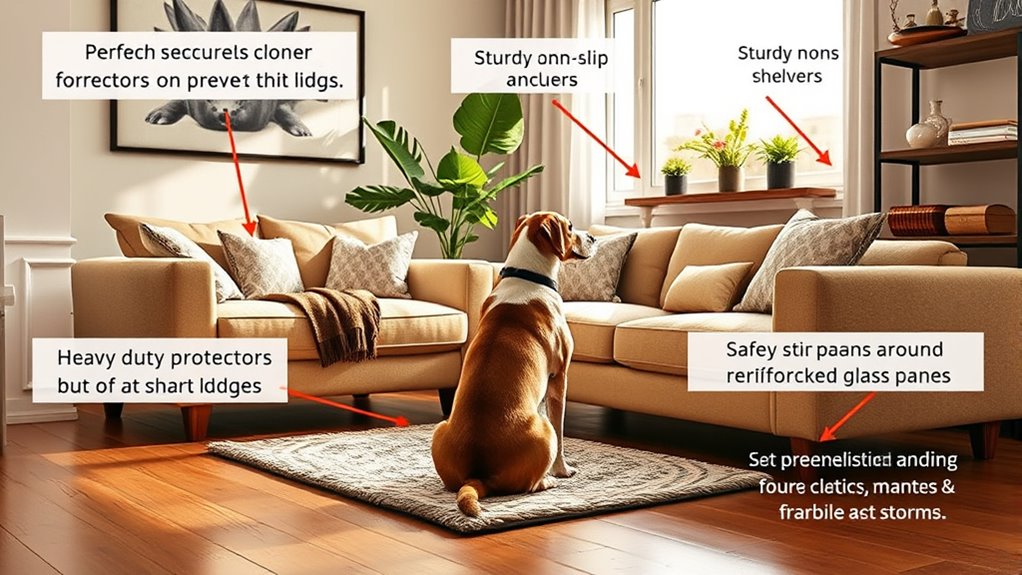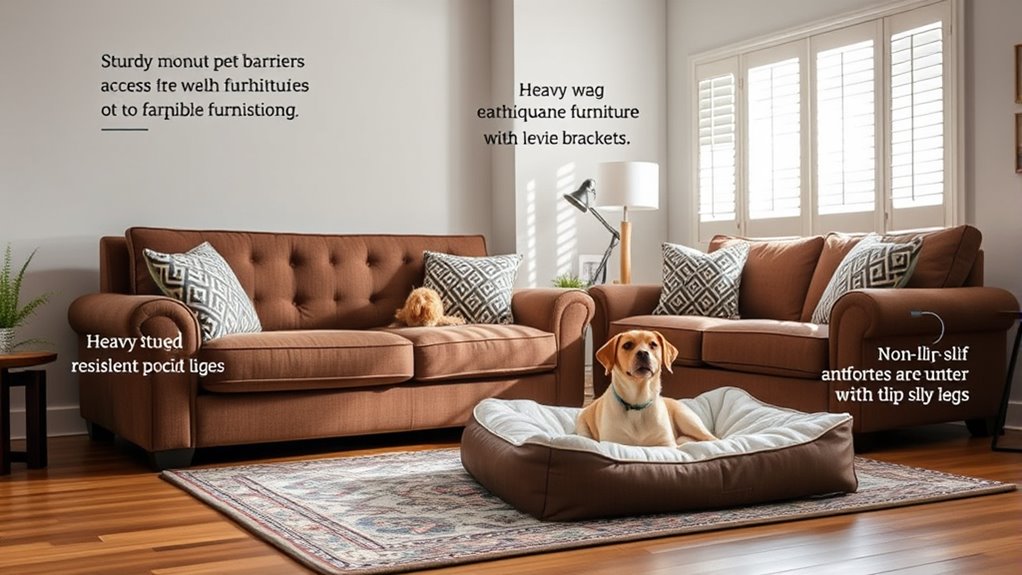To pet-proof your home against earthquakes and storms, start by securing furniture and shelves to walls to prevent tipping. Strap down heavy objects and secure loose items like decorations and cords to avoid hazards. Create a safe space for your pets with familiar bedding and toys, and store emergency supplies nearby. Regularly practice evacuation drills with your pets, ensuring their safety and comfort. Keep hazards minimized—if you want to learn more, stay tuned for practical tips that can help protect your pets effectively.
Key Takeaways
- Secure heavy furniture and shelves to walls to prevent tipping during earthquakes and storms.
- Anchor loose items like glass decorations and small objects to avoid projectiles.
- Strap down or stabilize cords and electrical devices to reduce tripping hazards.
- Designate a safe, enclosed space away from windows for pets during emergencies.
- Keep emergency supplies and pet-specific kits easily accessible and regularly updated.

When emergencies like earthquakes and storms strike, your pets’ safety depends on how well your home is prepared. Pet safety during these events hinges on your ability to implement effective emergency preparedness measures. The first step is to secure items that could pose a threat during a quake or storm, such as loose furniture, glass decorations, or heavy objects. Anchoring shelves, securing cords, and strapping down furniture minimizes the risk of injury from falling debris or shifting furniture. This not only protects your belongings but also keeps your pets safe from accidental harm.
Secure heavy and loose items to protect your pets during emergencies.
Next, create a designated safe space within your home where your pets can retreat during emergencies. This should be a small, enclosed area away from windows and exterior walls, ideally filled with familiar bedding, toys, and water. Having a reliable shelter reduces their anxiety and prevents panic during chaos. Incorporate pet-specific emergency preparedness into your plan by keeping a pet emergency kit nearby. Stock it with essentials like food, water, medications, a leash, and a recent photo of your pet in case you need to identify or find them. Including comfort items like their favorite toy or blanket can help ease their stress during a crisis.
It’s also critical to plan ahead for evacuation. Determine pet-friendly shelters or hotels in your area, and practice loading your pets into carriers quickly and calmly. Keep carriers accessible and comfortable, so pets are less stressed when it’s time to evacuate. Make sure your pet’s identification tags are up-to-date and consider microchipping as an added layer of security. This ensures that if your pet gets lost during a disaster, chances of reunification are higher.
Routine drills are essential for pet safety and emergency preparedness. Regularly practice what you’ll do in the event of an earthquake or storm, including how to evacuate with your pets. Familiarity with your plan reduces panic and confusion during the actual emergency. Additionally, understanding fire safety standards for home safety can help you prevent accidental fires that could threaten your pets. Remember, the key to pet-proofing your home is proactive preparation. By securing your environment, creating safe spaces, maintaining emergency supplies, and practicing evacuation plans, you’re considerably increasing your pets’ chances of staying safe and calm during a disaster. Being prepared not only safeguards your pets but also gives you peace of mind, knowing you’re ready to protect them when seconds count.
Frequently Asked Questions
How Can I Keep My Pets Calm During a Natural Disaster?
To keep your pets calm during a natural disaster, you should recognize pet anxiety and use calming techniques like gentle petting, soft voices, and familiar toys. Create a safe space where they feel secure, and stay with them to reduce fear. Keep routines consistent, and consider calming pheromone diffusers or music to soothe their nerves. Your presence and reassurance play an essential role in helping your pets stay calm.
What Emergency Supplies Should I Have Specifically for Pets?
They say, “Better safe than sorry,” and that applies to your pets too. You should have pet travel essentials like food, water, and medication, plus pet identification tags with current info. Don’t forget a sturdy carrier, a leash, and comfort items. These supplies help keep your pets safe and calm during emergencies, ensuring you’re prepared to act swiftly and reunite quickly if needed.
How Do I Create a Pet-Safe Evacuation Plan?
You need to develop a pet-safe evacuation plan by choosing reliable pet transportation options and ensuring your pets have up-to-date pet identification, like collars and microchips. Practice the plan regularly so your pets stay calm during emergencies. Keep a list of nearby shelters that accept pets, and pack an emergency kit for your pets. Clear routes and designate a safe space in your home to stay together during evacuations.
Are There Specific Pet-Proofing Tips for High-Rise Apartments?
In high-rise apartments, prioritize balcony safety by securing railings and keeping pets away from edges. Address high-rise hazards by anchoring furniture to prevent tipping during storms and ensuring windows are secure. Keep emergency supplies accessible, and consider creating designated safe zones. Always supervise your pets near balconies and windows, especially during storms or strong winds. These steps help minimize risks and keep your pets safe in your apartment.
How Do I Secure Outdoor Pet Areas Against Storms and Earthquakes?
When storms or earthquakes hit, don’t leave your outdoor pet area hanging by a thread. Secure it by reinforcing fences with sturdy posts and braces to withstand strong winds and tremors. Add shade protection to shield your pets from the sun or rain during bad weather. Think of it as putting a safety net in place—you’re safeguarding your furry friends from the unexpected, ensuring they stay safe and comfortable no matter what comes your way.
Conclusion
Just as a lighthouse guides ships safely through storms, your preparedness shields your furry friends from danger. By pet-proofing your home against earthquakes and storms, you become the steady anchor in their unpredictable world. Remember, it’s not just about protecting possessions but safeguarding lives—yours and theirs. With thoughtful precautions, you turn chaos into calm, echoing the resilience of ancient guardians who faced nature’s fury with unwavering resolve. Your vigilance guarantees that love and safety always prevail.










